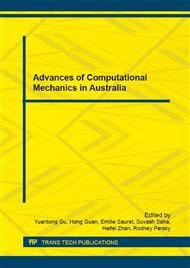p.500
p.506
p.512
p.518
p.524
p.530
p.535
p.541
p.547
A Numerical Study of Micro Hydro Deep Drawing of SUS304 Sheets
Abstract:
Micro forming is a promising technology and has drawn global attentions due to the urgent requirements on miniaturised products. Micro hydro deep drawing (MHDD) is a typical micro forming method and its products are widely applied in various fields, such as micro electro-mechanical systems (MEMS), medical and aerospace areas. However, tiny sizes of both products and tools are obstacles to investigate this novel technology. Therefore, finite element method (FEM) is adopted and modified to study the influence of processing parameters on micro drawing process and produced products. In this study, a normal hydro deep drawing model was developed, and then a voronoi blank model was generated to consider the size effects of materials. Additionally, a surface layer model was created based on the voronoi blank model. Therefore, the open and closed lubricant theory can be fulfilled and friction behaviour in MHDD can be considered. Subsequently, different processing parameters, such as hydraulic pressure and material inhomogeneity, were investigated. Simulation results indicate that a proper hydraulic pressure improves drawability and shape accuracy of the drawn cups. Moreover, material inhomogeneity affects the quality of drawn cups.
Info:
Periodical:
Pages:
524-529
Citation:
Online since:
July 2016
Authors:
Price:
Сopyright:
© 2016 Trans Tech Publications Ltd. All Rights Reserved
Share:
Citation:


